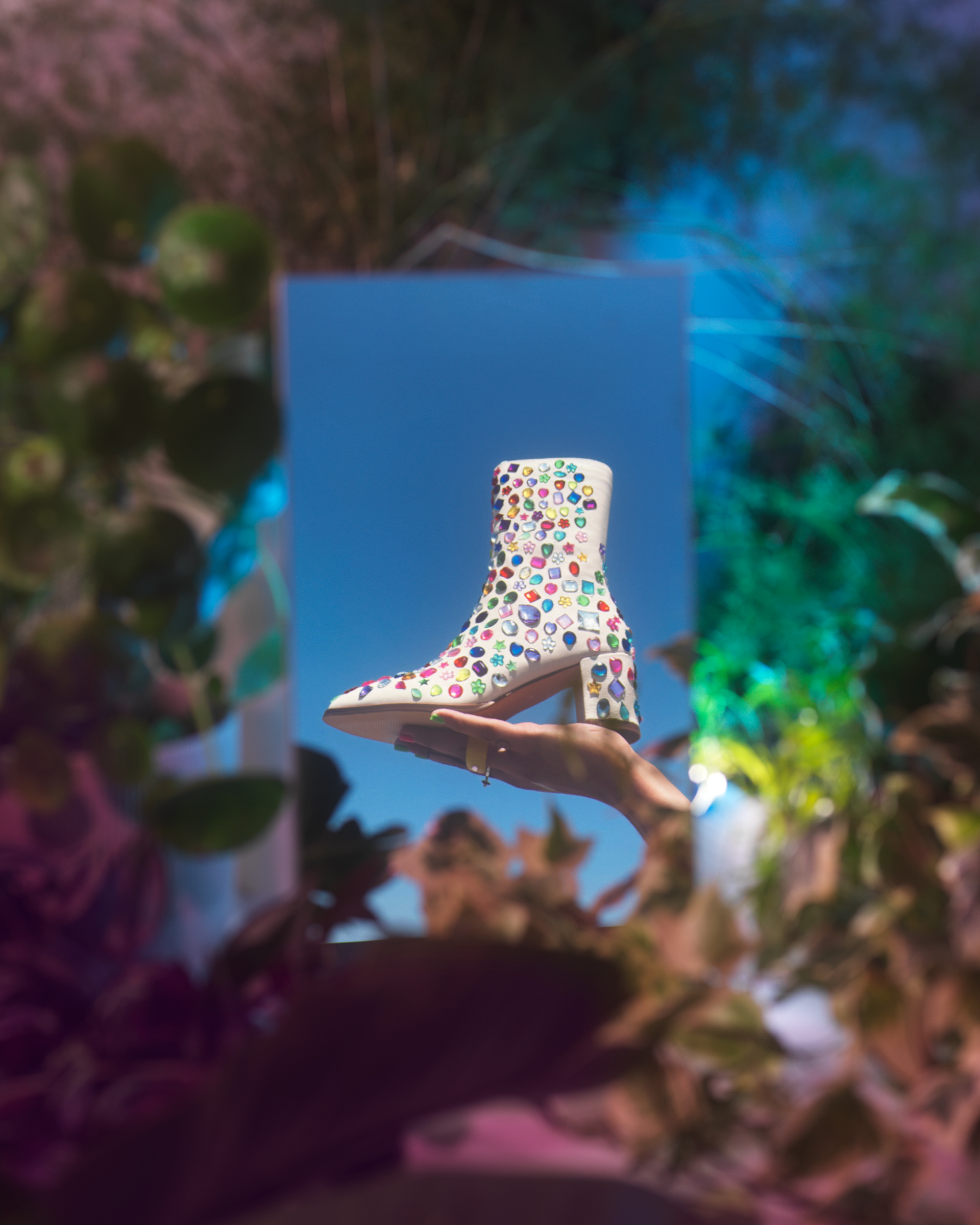Maria Raga never expected to be able to pull off a pair of yellow Versace pants like the ones she was wearing the day we spoke in July. Although she’s now the CEO of Depop, a popular clothing-resale app, she was hardly a lifelong fashionista. “Versace’s a brand that’s accessible for very, very rich people,” she says. “But I got it secondhand on Depop. It’s a very cool color. I can tell you nobody else in my circle of friends will be wearing something similar.”
Raga, 42, is not exactly in Depop’s core demographic: 90% of Depop’s 30 million active users across 150 countries are under the age of 26. She was skeptical of buying previously owned clothes after growing up in Spain on fast-fashion labels like H&M and Zara, brands that rose to prominence copying catwalk trends at a low cost, thus encouraging shoppers to accumulate and throw out clothes with each new season. “I only buy secondhand now,” she says. Depop, which allows members to set up online shops and buy and sell clothes, offers tens of millions of items at a relatively low price point and every niche you can imagine, whether you’re into “clown wear,” which looks exactly like what it sounds like, or “vintage” 2000s fashion, a depressing category discovery for anyone over the age of 30.
With the global pandemic disrupting supply chains, COVID-19 restrictions shutting down brick-and-mortar stores, and an economic downturn reducing many people’s disposable income, 2020 was a tough year for retail. A December 2020 report by McKinsey & Co. predicted that profits in the fashion industry would fall by 93% that year. Established names like J. Crew, Neiman Marcus, Lord & Taylor and J.C. Penney declared bankruptcy. During the same period, Depop sold some $660 million in merchandise, doubling sales from the previous year, thanks in large part to teens who were bored at home and scrolling on their phones even more than usual.
Read More: Remote Work Is All Gen Z Knows. But Are They Satisfied?
Depop was hardly the only upcycling company that saw success in 2020 (upcycling, for those unfamiliar with the term, is just a fancy way of saying resale), nor was its upward trajectory strictly attributable to the pandemic. The resale market has been gaining popularity over the past several years, and established retailers like Patagonia, Nordstrom, Levi’s, Burberry, Gucci and Walmart have all launched resale programs that they market as both affordable and eco-friendly. But last year, the demand reached a new level: the retail resale market, led by online marketplaces like Depop, The RealReal and Mercari, is now growing 11 times as fast as traditional retail, according to the research conducted by the firm GlobalData and the consignment company ThredUp. Shares of online resale market Poshmark more than doubled after its IPO in January 2021, and ThredUp’s stock went up 30% when it went public in March.
Since then, growth hasn’t been quite as steady, although the resale market in the U.S. is still projected to hit $64 billion by 2024, according to GlobalData. Poshmark and ThredUp both reported first-quarter earnings below analysts’ expectations, and Raga admits that although Depop enjoyed a big bump during quarantine, sales have been more volatile this summer. This may be because more people are visiting stores in person. But the company has also faced criticism as its higher-income sellers have raided thrift stores for items to resell on Depop, depriving people who actually need to buy secondhand of a robust selection. Still, Rent the Runway, which lost its $1 billion valuation during the pandemic, announced in June that it was expanding into resale, saying it had “noticed members buying pre-loved items from us at twice their usual rate.”
At least one company has placed an enormous amount of faith in the future of resale: in July, Etsy acquired Depop for approximately $1.625 billion. “We believe Depop to be the resale home for Gen Z consumers with a unique offering and highly engaged user base,” Etsy CEO Josh Silverman said in a press release. Unlike with other online retailers, where you simply browse and buy, shoppers on Depop can follow influencers, like and comment on their photos and send direct messages. This interaction fosters communities within the app, which has become a part of young people’s daily social media diet, and it creates devoted users: 75% of its sales are to repeat customers.
Trends come and go in fashion, but Depop seems to have recognized what the e-commerce industry as a whole has missed: it’s not just about the clothes, it’s about the experience. With the Etsy acquisition, they’ll have the opportunity to bring that experience to far more people. But if Depop has created a virtual version of hanging out at the mall with friends, what happens when the parents show up?
Scroll through Poshmark or The RealReal and you’ll see products, often hanging limply on mannequins, or a woman standing stiffly in her home. Scroll through Depop and you’ll see people out in the world, looking chic in wide-leg pants rolling in the grass or striking a pose in front of a haphazardly hung backdrop, perhaps decorated with pink cartoon cats and owls. On a recent day of browsing, I spotted classic items like Air Force 1 sneakers but also an orange crochet crop top with a heart in the middle that seemed to have started a bidding war.
There’s no single reason young users get hooked on Depop, but chief among the draws is the chance to be an influencer. Sellers model their wares on Instagram and TikTok in hopes of building large followings, and Depop does what it can to encourage this practice. Its two brick-and-mortar stores, in Los Angeles and New York City, have a sparse selection of clothes. Lights and cameras take up most of the space. Depop users can book a studio to shoot their looks in a more professional setting in hopes of improving their sales (and Depop’s 10% cut of those profits). As a result, Depop has to do barely any marketing.
That’s what attracted Raga to the company in 2014. As a founding member of a company called MyCityDeal that was later acquired by Groupon, she saw firsthand how difficult it could be to connect with potential users on social media to grow a business. “[Depop] has this organic engine. Its sellers would be promoting their shops on social media and recommending the platform, and it was just growing very much on its own,” she says.
It’s also what intrigued Etsy. “The community loves the product so much, they tell all their friends,” says Silverman. ‘Their competitors are spending $50 million or $100 million on marketing and not growing nearly as fast as Depop.”
Depop founder Simon Beckerman, who ran a fashion and culture magazine in Milan, started the site in 2011 as a way to connect his young, creative and stylish friends. He then recruited sellers who already had engaged followings on social media. The community grew from there. Depop moved its headquarters to London in 2012. Its sales jumped 80% from 2017 to 2020, when the overall resale market grew just 40%.
Read more: Farfetch CEO José Neves on How the Pandemic Drove Fashion Sales Online
Nowadays, search enough corners of that community, and you can find incredibly narrow categories, like “cottagecore” or “dark academia,” recent trends propelled by viral videos during the pandemic of moody-looking girls sitting around cottages and university libraries. Amanda Adam, 27, co-runs a Depop page with her friend Piper Cashman, 26, in L.A. and markets heavily through Instagram, where their shop, Zig Zag Goods (tagline: “Contemporary clownwear for the everyday freak”), has more than 72,000 followers. They sell what Adam calls “kidcore,” brightly colored shirts with smiley faces drawn on them or bright blue fishnet dresses worn over bright orange T-shirts—clothes that are supposed to make you feel nostalgic for childhood even as they reveal a bit of skin.
“Poshmark and Etsy, they’re geared toward older artists and moms that need to purge their wardrobes,” Adam says. “I don’t understand Poshmark. You press and make an offer and they accept it. There’s no dialogue there, whereas I think my generation expects to talk to people online.”

Like many of Depop’s users, Sydny Boney, 22, joined because she needed a side hustle. During her final semester at Howard University last year, she found herself living in her childhood bedroom in Maryland. She had a sneaker habit to fund and a dream of buying and renovating a school bus and living in it for several years.
So in August 2020, remembering that a friend had made $20 selling a pair of shoes on Depop, she hung up a Hello Kitty sheet as a backdrop in her room and began modeling some of her clothes. Then she started making the rounds of 12 thrift stores within driving distance of her home. What she bought and sold depended on her mood—sometimes she photographed herself dressed up like a fairy, sometimes in streetwear.
She earned enough money to buy the $5,500 bus in a little less than a year selling on the app, and once she renovates it, she plans to drive across the country offering pop-up shops she will promote on Depop and Instagram. “My dad doesn’t really get it. It’s so different than what he thought I was going to be doing,” says the former biology major. “But I get to work on my own terms. Just make some money and live as freely as I like to.”
Peter Semple, the chief brand officer at Depop, notes that Gen Z shoppers have a particularly fluid relationship with gender and sense of self-presentation: “People move between tribes because, obviously, this particular young generation are reinventing their style and identity and self-expression more frequently than any generation before.” Influencer culture has no doubt fueled that mentality. The fashion forward never want to post the same outfit to their Instagram feed twice and are constantly refreshing their closets. Even fast fashion cannot keep up. A trend may last only a few months, and Depop’s success during the pandemic was, in part, a logistical victory. A brand might have recognized the need to pivot to loungewear during lockdown but because of COVID-19-related hiccups was unable to ship out sweatpants quickly enough to meet customer demand. Depop’s inventory was already in its users’ closets.
"Thrifting as a culture has grown immensely and it’s kind of diluted the whole beauty of finding treasures.”
But upcycling does more than just restock wardrobes in a timely fashion. For decades, environmentalists have been sounding the alarm on fast fashion. The low prices at stores like Forever 21 taught consumers that a shirt didn’t have to last very long because you could always buy a trendier one in a few months. Those habits had atrocious effects on the environment. (The fast-fashion industry has also come under fire for contributing to worker abuse.)
Depop isn’t a repudiation of fast fashion so much as an evolution. It cuts down on waste, but the low prices and the pace with which consumers move through trends is the same. “People still want the feeling of new,” says Justine Porterie, Depop’s global head of sustainability. “We’re not going to tell you to stop buying. We’re going to ask you to buy within planetary boundaries.” Silverman says his daughter, who is 16, keeps only 10 shirts in her wardrobe. “If she wants a new one, she’ll sell one to make space for the other,” he says.
Depop heavily markets its eco-friendly branding and announced plans to obtain the “Climate Neutral” label—which involves purchasing verified carbon credits to retroactively offset all sellers’ shipping emissions since January 2020—from South Pole, a climate-solutions consultancy, by the end of 2021. That should appeal to Gen Zers, who are more likely than any other generation to count climate change as their “top personal concern,” according to a Pew Research Center survey conducted in April.
But for all of Depop’s virtue signaling about its eco-friendly practices, ask its sellers why they’re on the app and they’ll likely cite some combination of access to cute clothes, affordability and chatting with a community of like-minded fashionistas before they mention that their purchase is green, too. The goal, Raga argues, is not for shopping to be virtuous but for virtuous shopping to be easy. It’s hard to persuade people who do not prioritize sustainability to shop this way, she says. But if it can make upcycling simple and fun, an addictive app can become a Trojan horse for do-gooder behavior.

Depop’s rapid growth has not been without challenges. Over the past year, the app has become the focus of a debate over gentrification in thrifting. In order to promote their shops, many Depop users post videos and TikToks of themselves visiting thrift stores, Goodwill, garage sales and the like and searching for treasures. Some model the items to lend them cache, then sell them at a higher price. Others modify the clothes, painting them, mending them or making them smaller before selling them and turning a profit. Critics have taken to social media to complain about these “haulers”—Depop sellers who purchase huge amounts of secondhand clothing purely to resell. They argue that these often middle- and upper-class sellers deny inventory to people who cannot afford new clothes.
Semple points out that some charities had to stop taking donations during the pandemic because they were receiving so many clothes from people decluttering their homes. Even before that, charity shops put out only a fraction of their wares at any time, according to Portiere, which meant many of the clothes weren’t actually seen. Depop partnered with several nonprofits, creating and promoting accounts for them to offload extra inventory and operate safely during lockdown. “We intend on building those relationships and offer them a new outlet to reach more people,” Semple says.
"Sustainability is not something that is solely for the white middle-class lady who wears linen and stuff that is super expensive and inaccessible.”
Adam and her partner expect to do $100,000 in sales of their “kidcore” clothes this year through a combination of Depop sales and direct sales on a website they built, but it hasn’t been easy. Adam says she’s been thrifting since middle school and has seen prices go up. “Some of my favorite stores have just been purged completely from the good items,” she says. “Honestly, that’s why I turned to the app in the first place to find good stuff. Thrifting as a culture has grown immensely and it’s kind of diluted the whole beauty of finding treasures.”
She says that at many thrift stores, people will wait for the bins to roll out with new products and push one another aside to get the best pieces. “I try to take the reject pieces and find a way to make them cool,” she says. “It’s a challenge, but the great thing about upcycling is giving life to something that was disregarded by so many people.”
Depop has also been accused of a lack of diversity both on the platform and at the company. It’s been called out repeatedly over the years by those who say its algorithm chooses mostly cisgender white women to feature on its “Explore” page. In June 2020, Depop posted a statement on Instagram vowing to “make it easier to shop and discover Black and POC sellers on the Explore page” and “increase representation of Black and POC on all teams,” admitting that at the time no one on its management team was Black and only 11% of its employees were. “Diversity is super, super important to our audience, so for us it will always be important to make sure that we’re inclusive in our ranks and in the way we portray our users,” Raga says.
Inclusivity is also a personal goal for Porterie. She comes from what she describes as a “humble” background in France and says she wanted to work on sustainability because low-income people across the world are the ones most affected by climate change. “In the sustainability world, the diversity is not amazing. There aren’t so many people who look like me,” she says. “But sustainability is not something that is solely for the white middle-class lady who wears linen and stuff that is super expensive and inaccessible.”
Many users push back against some of the accusations Depop has faced. “I’m biased because I feel Depop has offered me opportunities as a Black girl,” says Boney. “I live in a little small town, and I haven’t seen thrifting prices go up.” In fact, thrift-store workers often take her into the back to show her the many garments they don’t put on the floor. “I honestly think they do a good job featuring different body types and gender fluidity. And I see a lot of people who look like me being promoted on the ‘Explore’ page.”
One of Depop’s pitches to users as recently as 2020 was that they could start a business from their bedrooms, but Depop is their main source of income for only a small percentage of users. “The majority of our sellers are casual,” says Raga. “Instead of playing an instrument, they are finding a hobby through Depop.”
There are the much-talked-about Depop success stories, like Bella McFadden, known as Internet Girl, the 26-year-old who has made $1 million on the app. But several people I spoke to could not even ballpark their profits, despite selling on Depop for more than a year. Boney, for example, can’t quite pinpoint how much money she has made once she counts the costs of buying backgrounds for her shoots. “Honestly, I don’t want to do Depop forever because it takes 10%,” she says. “I want to create a website where I have more control.”
Read More: How Tech-Boosted Astrology Apps Are Filling a Void
Silverman compared Depop to “today’s version of a paper route.” Except the paper route is a solo endeavor, and on Depop you’re doing it with your fellow creatives. Adam says she joined Depop because she liked the idea of having her own income as a college student. “But really I just had this love affair with the app,” she says. “I just wanted to spend all this time in this community getting inspired by how people were taking photos and branding themselves.”
Depop has a business imperative to expand that community. “Right now they have less than 2% market penetration in the retail resale market,” says Shweta Khajuria, the director of Internet Equity Research at investment-banking advisory firm Evercore. “So that’s a lot of opportunity to grow.” But apps also tend to get less cool as they get popular. Millennials complained that Boomers ruined Facebook. Gen Z is now complaining that millennials are ruining TikTok. The average age of an Etsy customer is about 39. Or in the words of one of my (millennial) friends, Etsy is for “millennial women knitting Harry Potter-themed things.”

Lindsay Street, a 33-year-old in Baltimore who quit her job during the pandemic to sell items on both Depop and Etsy, says Depop is the more laid-back and enjoyable experience. “Without being terribly disparaging of Etsy,” she says, “it’s just a bit harder selling on Etsy in terms of expectations of people wanting questions answered. Depop is a little less corporate, a little more creative.”
Raga says she agreed to the acquisition only because Etsy had a track record of leaving well enough alone. The company acquired the musical-instruments marketplace Reverb in 2019, and it has helped scale the business while leaving the aesthetic largely untouched. She points to Facebook as one model for growth. “What they did is started with university kids and little by little started to grow to all generations,” she says. That might be bad news for Depop’s current users: Edison Research found in 2019 that Facebook’s number of users ages 12 to 34 declined 17% in just two years. But Facebook now has 2.89 billion users and is worth $1 trillion.
Semple, meanwhile, cited a company that has managed to stay cool for decades: Nike. “They’re one of the few brands of the world that constantly reinvent, constantly innovate,” he says. Nike, now a $76 billion company, still manages to stay desirable enough that customers camp out overnight for new sneaker drops.
One key difference, of course, is that Nike shot to superstardom by hitching its wagon to Michael Jordan, while Depop relies on often hyper-specific influencers to appeal to niche audiences. But maybe that’s the only way for Depop to remain Depop. “Etsy is kind of for everyone,” Boney says. “I think it’s nice to keep Depop more like our own little place where you can go to find exactly what you’re looking for, even if what you’re looking for is super, super weird.”
Correction, August 19
The original version of this story misstated how many of Depop’s users are under the age of 26. It’s 90% of the app’s active users, not 90% of its registered users.
More Must-Reads from TIME
- How Donald Trump Won
- The Best Inventions of 2024
- Why Sleep Is the Key to Living Longer
- Robert Zemeckis Just Wants to Move You
- How to Break 8 Toxic Communication Habits
- Nicola Coughlan Bet on Herself—And Won
- Why Vinegar Is So Good for You
- Meet TIME's Newest Class of Next Generation Leaders
Write to Eliana Dockterman at eliana.dockterman@time.com
